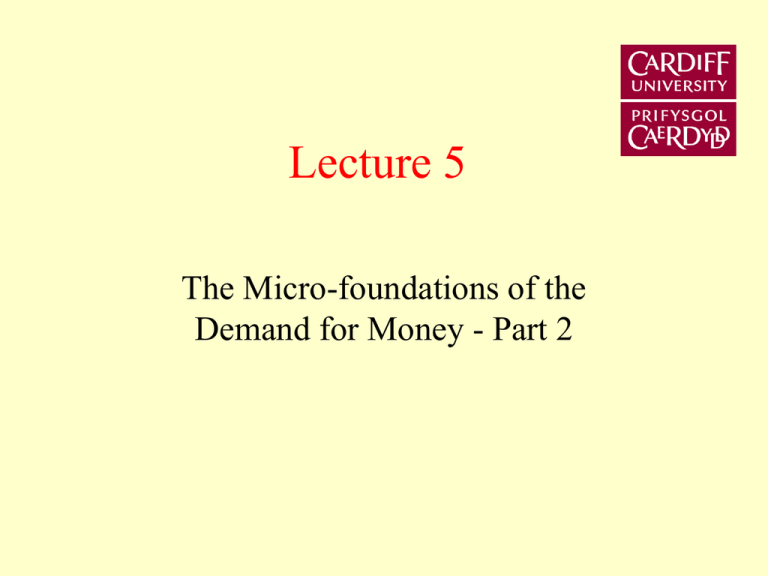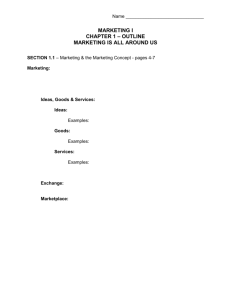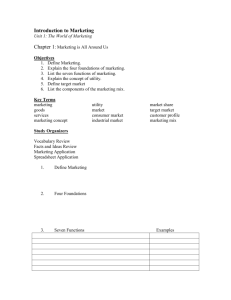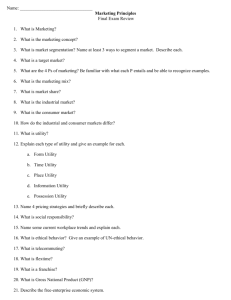The Microfoundations of the Demand for Money Part 2
advertisement

Lecture 5 The Micro-foundations of the Demand for Money - Part 2 • State the general conditions for an interior solution for a risk averse utility maximising agent • Show that the quadratic utility function does not meet all these conditions • Examine the demand for money based on transactions costs • Examine the precautionary demand for money • Examine buffer stock model of money The Tobin model of the demand for money • Based on the first two moments of the distribution of returns • Generally a consistent preference ordering of a set of uncertain outcomes that depend on the first n moments of the distribution of returns is established only if the utility function is a polynomial of degree n. • Restricting the analysis to 2 moments has weak implication of quadratic utility function Arrow conditions • • • • Positive marginal utility Diminishing marginal utility of income Diminishing absolute risk aversion Increasing relative risk aversion Arrow conditions dU 0 dR d 2U 0 2 dR U ( R) d ( ARA) ARA ; 0 U ( R) dR RU ( R) d ( RRA ) RRA ; 0 U ( R) dR Quadratic Utility Function U Max U U(R) R Alternative specifications • Set b > 0 - but this is the case of a ‘risk lover’ • A cubic utility function implies that skewness enters the decision process - not easy to interpret. • But the problems with the quadratic utility function are more general A Paradoxical Result E (U ) a R b R2 b R2 E (U ) E (U ) a E (U ) 2 R R b b 2 2 a a2 E ( U ) a 2 R R R b 4 ab b 4 ab 2 R Equation of a circle R 45o -a/2b R The Opportunity Set Since R = r Then R r R g r R R g R P’ P C B A 0 =1 R Implications • Slope of opportunity set is greater than unity • wealth effect will dominate substitution effect • for substitution effect to dominate r < g • bond rate will have to be lower the volatility of capital gains/losses Transactions approach • Baumol argued that monetary economics can learn from inventory theory • Cash should be seen as an inventory • Let income be received as an interest earning asset per period of time. • Expenditure is continuous over the period so that by the end of the period all income is exhausted Assumptions • Let Y = income received per period of time as an interest earning asset • Let r = the interest yield • Expenditure per period is T • Suppose agent makes 2 withdrawals within the period - one at beginning and one before the end. More ? • Suppose 0 < < 1 is withdrawn at the beginning of the period • Interest income foregone = (average cash balance during the fraction of the period) x (the interest rate for the fraction of the period ) • (Y/2)(r) = ½ 2rY More • Later (1- )Y is withdrawn to meet expenditure in the remainder of the period (1- ) time • Thus agent gives up ½(1- )2rY • Let total interest foregone = F • F =½ 2rY + ½(1- )2rY • What value of minimises F? Minimisation F rY (1 )rY 0 1 2 Both withdrawals must be of equal size Y Y/2 t=½ t Optimal withdrawal • Calculate optimal size of each withdrawal • Gives optimal number of withdrawals • The average cash held over the period is M/2 • Interest income foregone is r(M/2) • assume that each withdrawal incurs a transactions cost ‘b’ Optimal money holding M C nb r 2 Y n M Y M C b r M 2 C bY 2 r 0 2 M M 2bY M r Elasticities ln M 1 2 ln 2 ln b ln Y ln r d ln M 1 MY 2 d ln Y d ln M Mr 12 d ln r 2(b)(Y ) 2 2bY 2bY M r r r Miller & Orr • 2 assets available- zero yielding money and interest bearing bonds with yield r per day • Transfer involves fixed cost ‘g’ independent of size of transfer. • Cash balances have a lower limit or cannot go below zero • Cash flows are stochastic and behave as if generated by a random walk Miller & Orr continued • In any short period ‘t’, cash balances will rise by (m) with probability p • or fall by (m) with probability q=(1-p) • cash flows are a series of independent Bernoulli trials • Over an interval of n days, the distribution of changes in cash balances will be binomial Properties • The distribution will have mean and variance given by: • n = ntm(p-q) • n2 = 4ntpqm2 • The problem for the firm is to minimise the cost of cash between two bounds. Cash balances H Return point = H/3 L Time The costs of managing the cash balance is; Buffer stocks and Disequilibrium Money T C a Mt M t 1 * 2 t bM t M t 1 2 C 2a M t M t* 2bM t M t 1 2bM t 1 M t 0 M t M t AM t* BM t 1 BM t 1 Aa a 2b ;B b a 2b ; A 2B 1 C 2a M t 1 M t*1 2bM t 1 M t 2bM t 2 M t 1 0 M t 1 In period T at the Terminal date MT+1 = MT C * 2a M T M T 2bM T M T 1 0 M T a * b MT M T M T 1 ab ab Generalising for an errorcorrection mechanism M kYt 1 * t M t M M t 1 * t 1 M t M ( 1) M t 1 * t M t kYt 1 M t 1 M t ( M t 1 kYt 1 ) Disequilibrium Money causes adjustments in all markets Yt ( M s t 1 M ) d t 1 Yt M t 1 kYt 1 Conclusion • Post Keynesian development in the demand for money have micro-foundations but they are not solid microfoundations. • The Miller-Orr model of buffer stocks money demand allows for disequilibrium and threshold adjustment. • The macroeconomic implication is the disequilibrium money model. • The disequilibrium money model builds on the real balance effect of Patinkin and has long lag adjustment of monetary shocks • Equilibrium models have rapid adjustment of monetary shocks (rational expectations).







